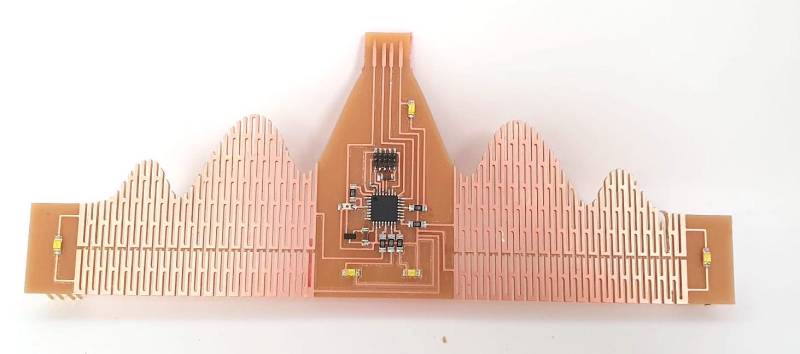Printed circuit boards can be square, round, octagonal, or whatever shape you desire. But there’s little choice when it comes to the third dimension: most PCBs are flat and rigid. Sure, you can make flexible PCBs like the kapton-backed ones you find inside electronic gadgets, but those are complicated to work with. As it turns out however, you can also make flexible boards using regular PCB material: check out [Rehana Al-Soltane]’s Flexible Crown PCB, a project she did as part of [Neil Gershenfeld]’s “How To Make (Almost) Anything” class at MIT.
The basic idea is to create flexures in the PCB by milling out several long slots with thin pieces connecting the two sides. [Rehana] got this idea from [Quentin Bolsée]’s flexible capacitive sensor project and applied it to make a crown-shaped PCB with sparkly LEDs. The crown can bend through 180 degrees and can actually be worn as a head ornament, with pin headers to clamp it down on the wearer’s hair.
[Rehana] used a tool called svg-pcb to design the board. This is an open source toolkit that lets you design PCBs by describing them in code, rather than drawing shapes by hand. Although this might look a bit odd if you’re used to working with traditional PCB design software, it’s ideal for making repetitive structures like the flexures in the crown: simply write a for loop and let the tool generate a perfect array of identical slots.
Fabricating the Flexible Crown posed a few difficulties of its own, because the PCB began to flex and wiggle itself loose before the milling process was finished. As it turned out, the trick was to cut all the slots on the interior first and only mill the board’s outline as the very last step.
Adding flexures to a PCB like this looks like a promising technique and we’ll keep an eye on further developments in this field. There are other ways of making bendy boards though: researchers at the University of Maryland used a laser engraver to make foldable PCBs. Our 2019 Flexible PCB Contest also yielded several impressive implementations.















“with pin headers to clamp it down on the wearer’s hair.”
Well, that rules me out!
B^)
Pogo pins that go into the skin…
In 1972, Elementary Electronics had an “aeroband receiver” (a vhf crystal radio) and they suggested building it on flex circuit board. Either the magazine sold some, or it could be had at a regular supplier like Allied.
I remember that article!
Didn’t it start with some sort of “conversation” between seat neighbors about how many planes were in line to take off before them?
Maybe. The whole idea was a crystal radio wouldn’t interfere, and if yiu hide it in your clothes with just a transistor rsdio earphone in yiur ear, nobody will notice.
Crystal radios are still used even today. Otherwise how could you explain that a teenage twink defeats world champion and his moves match 1:1 what Rybka engine does?
Butt stuff. Surprisingly, it’s a proven alternative, and (hopefully) nobody is going to check there
And they almost certainly meant something like a breadboard, where “flexible” means “repurposable”, and not “bendable”.
No, it was bendable.
I certainly remember adverts for flexible pcb materials in the ’70s, where the photographs and body text made it clear that they meant physical flexing.
Even back then, people were beginning to think about wearable electronics.
You don’t have to cut all the way through the board to bend it. Years ago, a product I designed had a keyboard and LED display for a product. For appearance, they wanted the display to be angled toward the viewer. Rather than the cost of two PCBs with a cable between them, we had the PCB vendor skive 1/2″ of the board to about half thickness between the keyboard and display. That was enough so the PCB could be bent to the desired angle. A little heat was all it took to make the bending easy, and to retain its shape when it cooled.